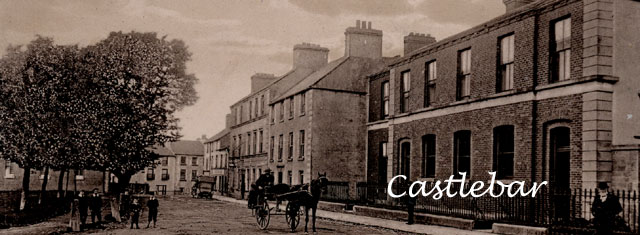
| WALSH/LANGAN INTRODUCTION - HOME PAGE | |

| |
| My ancestors John Walsh and Fanny Feeney were married in Castlebar
in 1857. It is highly likely that the Feeneys and/or the Walshes lived in Castlebar before the marriage.
|
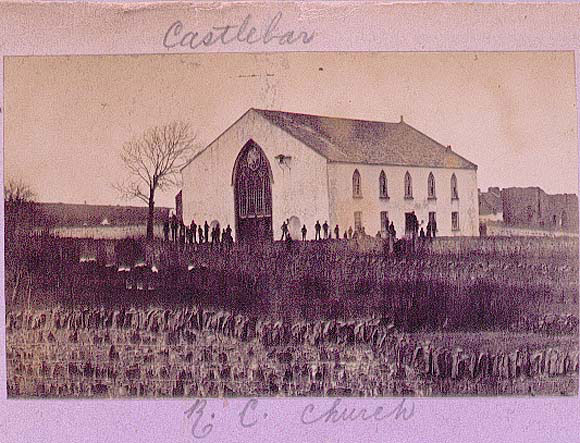
|
| With the kind permission of the National Library of Ireland - Library Reference Number: WYN12 |
| Catholic Church, Castlebar, Co. Mayo by Wynne, Thomas J 1838-1893 photographer ca.1880 This is the church where John Walsh and Fanny Feeney were married. Ivor Hamrock of the Castlebar Library says that this is the Catholic Church "which was demolished after the Church of Our Lady of the Holy Rosary was completed in 1901." |
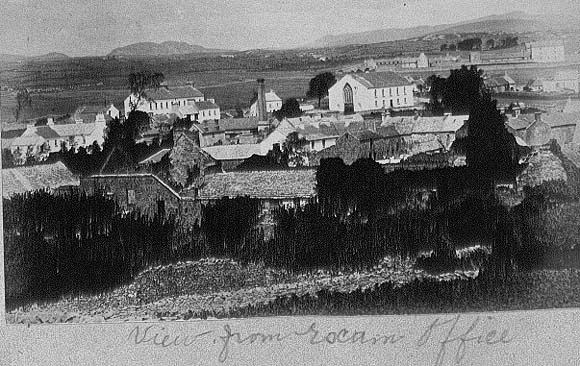 |
Wynne Collection, National Library of Ireland
|
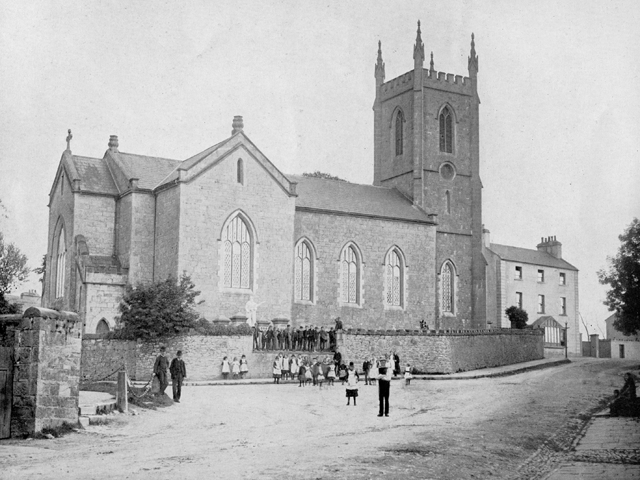
|
| Collection of Maggie Land Blanck |
| No date. Torn out of some picture book. The picture was labled "Roman Catholic Church, Castlebar". However Ivor Hamrock of the Castlear Library tells me that this is "Christ Church which is the protestant church and dates from 1739. It is still standing but only used occasionally for funeral for funeral services."
|
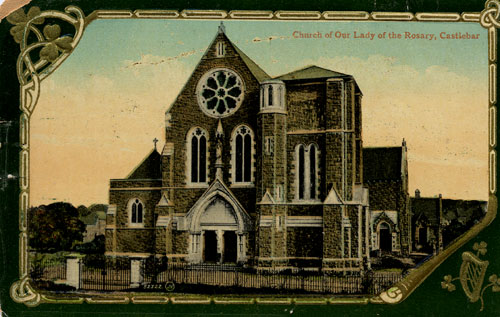 |
"Church of Our Lady of the Rosary, Castlebar"
This is not the church in which John Walsh and Fanny Feeney were married. The building of this church started in 1897. the church was dedicated in 1901. Not posted |
| Postcard collection of Maggie Land Balnck | |
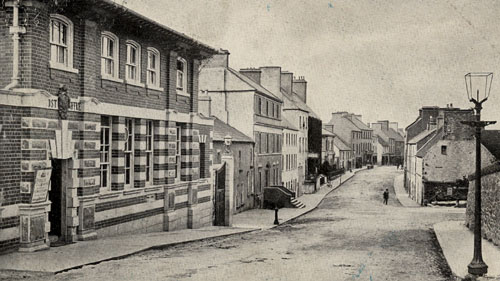 |
"Ellison Street, Castlebar"
Not posted |
| Postcard collection of Maggie Land Balnck | |
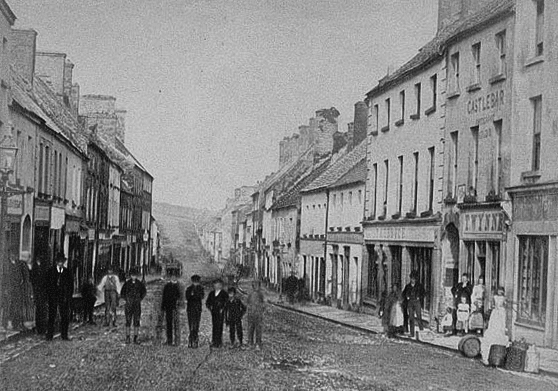 |
Wynne Collection, National Library of Ireland
Main Street, Castlebar |
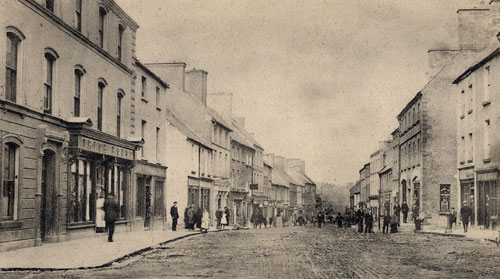 |
"Main Street, Castlebar"
Not posted |
| Postcard collection of Maggie Land Balnck | |
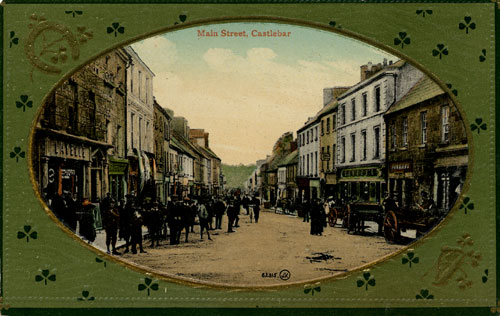 |
"Main Street, Castlebar"
Not posted |
| Postcard collection of Maggie Land Balnck | |
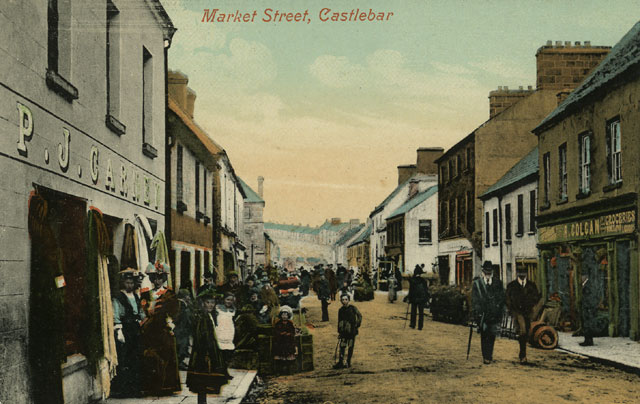
| |
| Postcard collection of Maggie Land Blanck, June 2004 |
|
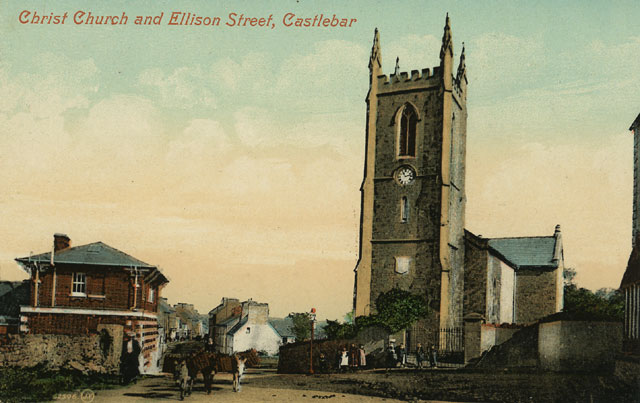
| |
| Postcard collection of Maggie Land Blanck, June 2004 |
|
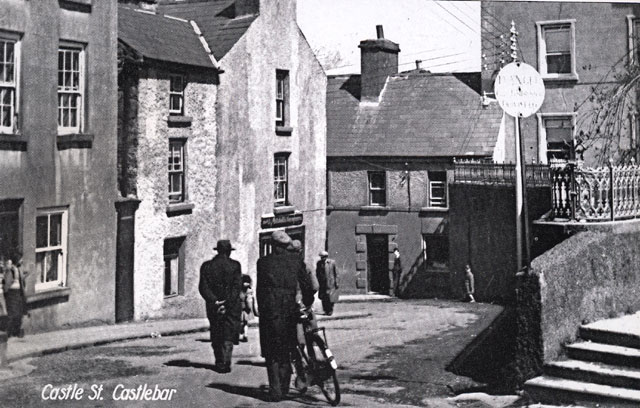 | |
| "Castle Street, Castlebar" | |
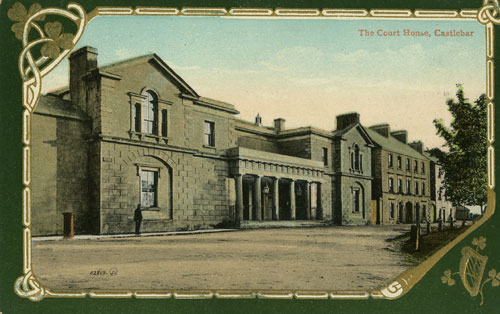 |
The Court House, Castlebar |
| Postcard collection of Maggie Land Blanck | |
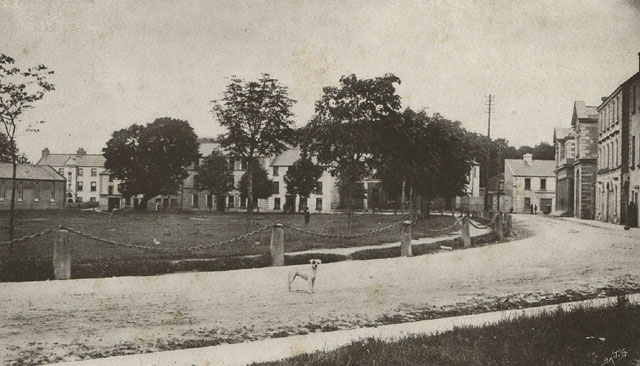 |
|
| Postcard collection of Maggie Land Blanck The Mall, Castlebar, photo by R. J. Wynne, Castlebar | |
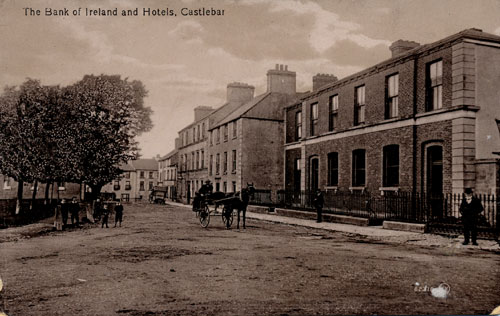 |
"The Bank of Ireland and Hotels, Castlebar"
Not posted |
| Postcard collection of Maggie Land Blanck | |
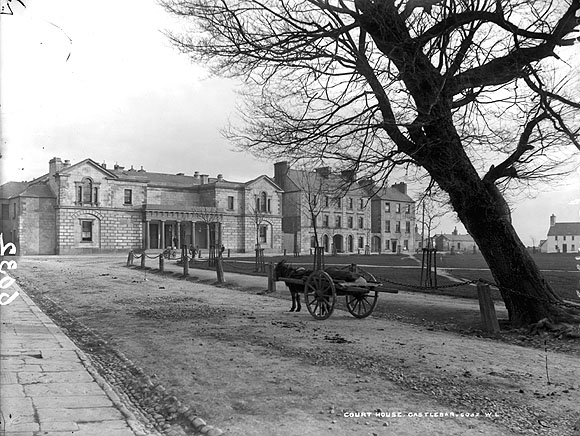 |
|||
| Lawrence Royal Collection, National Library of Ireland, Copyright National Library of Ireland
| Court House, Castlebar, | ||
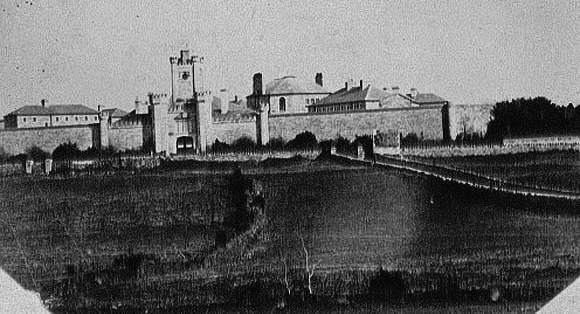 |
Wynne Collection, National Library of Ireland
Court House, Castlebar, |
| Castlebar Land Lords Lord Lucan was one of the most notorious landlords in Ireland. He held large estates in Castlebar; about 15,000 acres. For more information on Lord Lucan go to Landlords |
| Some Impressions of Castlebar A journey throughout Ireland, during the spring, summer, and autumn of 1834 By Henry David Inglis
"Castlebar is not so pretty a town as Westport; but it is a place of greater business; and it is a considerably large and more populous town. There is only one good street in Castlebar; but the town contains many lanes; and has very long, bad suburbs of mud cabins."For a while the contruction of the gaol and barracks had been a source of local employment. However, with the completion of those two projects the labor market was more "overstocked" than previously. Lord Lucan was described as "a tolerably fair landlord". A Topographical Dictionary of Ireland by Samuel Lewis, 1837 A market, post town and Parish in the barony of CARRA, county of MAYO. Contained 11,805 inhabitants with 6,373 living in the town. "The town is situated on the river Castlebar, which has its source in Lough Lanark, and on the mail coach road fro Ballinasloe to Westbort: it consists of one principle street nearly a mile in length, from which diverge several smaller streets and lanes ; and in 1831 contained 909 houses, some of the best of which are built around the green, which forms a pleasant promenade ; the streets are paved and kept in repair at the expense of the county."There was a military barracks with 60 artillery, and "24 officers and 565 non-commissioned officers and privates" in the infantry. Local manufacture and employment included: linen weaving, tobacco, snuff, soap candles, a brewery, a tannery, turf (or peat) gathering, and limestone quarrying. There was a Saturday market and fairs were held, May 11, July 9, September 16 and November 18. Assizes, quarter sessions, and petty sessions were held at the court house. The gaol had 140 cells. The average number of prisoners in 1831 was 181. The prisoners were employed chiefly in "breaking stones". The Church of Ireland church was build in 1828. The Roman Catholic " chapel" was "a spacious slated edifice". The Parliamentary gazetteer of Ireland: adapted to the new poor-law ..., 1844-45 Castlebar "on the main road from Dublin to Westport". While the square "has an appearance of considerable pretension" "all the rest of the town, consisting of lanes and alleys near the centre, and of streets straggling away, in suburban order, from the main body, is altogether of hamlet character, and rarely boasts a better building than a poor thatched cabin." ...... "the town is neither paved, lighted nor wathced." The "castle' for which the town was named was the stronghold of the DeBurghs. The Catholic Church was of "large proportions" and "substantial masonry". The Prison on inspection day 1840 — "26 females and 98 males ; and were found to be occupied as follows, — 20 females at work, and 6 at prison duties, — 44 males at useful trades, 19 at stone-breaking, 26 at tread-wheel, and 9 at prison duties. On Dec, 31, 1842, the prisoners were 45 male depters, 1 female debtor, 103 tried male criminals, 17 untried male criminals, 22 tried female criminals, 12 untried female criminals, 6 sick in hospital, 2 male lunatics and 3 female lunatics. The total number confined during 1842 was 1,171 ; the average number at one period, between 168 and 169; the maximin number, 210 ; the number of cells, 128,; the number of beds in other rooms, 60.Trade — Linen, brewery, tannery, day labor, agriculture. Statistics — Acres: 459 acres, TPopulation of the town in 1831 — 6,373, in 1841 — 5,137. Houses 769. Males above 5 years of age who could read and write 1,104; who could read but not write, 274; who could neither read not write, 741. Females above age 5 who could read and write, 733; who could read but not write, 489; who could neither read nor write, 1,171, The Saxon in Ireland : or, The rambles of an Englishman in search of a ... By John Hervey Ashworth, 1851 "I took up my quarters at an inn near the church, overlooking a handsome green, planted with trees, and surrounded by good houses and public buildings; but, as usual in this untidy country, several ruined and roofless buildings were intermixed with them, such as the wretched old goal, spoiling the general effect.""The Lawn" was the residence of Lord Lucan: "who is the great proprietor of the district. His lordship is also an improver on a large scale..... destroying many of the small holdings, and laying out his lands for larger occupation. There certainly appears, at first, no small amount of hardship inflicted by this mode of proceeding; but it must ultimately work well for the people themselves, and tend materially to rescue them from their present state of degradation..... Their estates, or large portions of the, are frequently in the hands of a numerous, moneyless, spiritless tenantry, who care not, if they can only eke out a bare existence from year to year. They agree to rents which they cannot pay if any casualty occurs; and if the landlord enforces his claim, they either shoot him or his agent, or selling their produce, pocket the rent and take their dishonest gains to America.""If Ireland is ever to rank among the civilized countries of the world, it must be though the operation of mighty changes in the present system." Italics mine. Letters from Ireland By Harriet Martineau, Reinhard S. Speck, 1852
"While within the town of Castlebar there is a general air of poverty and negligence, there are in the neighborhood a god many unfinished roads —" There were apparently a large number of roads that had been started as work project during the famine but had never been finished. This roads were infamous because the men who worked the were so malnourished that they fainted and died from hunger. "The men who were to earn their meal by working on the roads, could not work on the roads for want of that very meal."The local population were upset that Lord Lucan was taking large tracts of land around Castlebar and was raising stock. The local workhouse inmates were mostly aged, informed or children who were not capable of working to help support the workhouse. A number of young women, who declare themselves healthy and active" were assisted by the local Board of Guardians to immigrate. The population of Castlebar before the famine was declared to be 6,000 and by 1852 was stated to be between 3,000 and 4,000. "many have gone to the grave; but more have removed to other countries. Large sums are arriving by post, to carry away many more." Handbook for travellers in Ireland by John Murray 1878 "Castlebar is a good looking place, with all the buildings necessary to a small country town, viz. gaol, court-house, and barracks, in addition to a shady and well-timbered mall, which is certainly a very pleasant adjunct. The Lawn is the residence of the Earl of Lucan, who had done more than any landlord in the country to improve the agriculture of this district of which he owns 30,000 acres."Chambers's encyclopaedia: a dictionary of universal knowledge, Volume 2, 1901 "Castlebar, the capital of County Mayo, Irelad, on the Castlebar River, 152 miles NW of Dublin by rail. It has a good market, several breweries, and some trade in linen and agricultural produce. Here the Irish in 1641 massacred the English garrison. In 1798 the French general, Humbert, held the town for a fortnight. Population (1881) 3,855; (1891) 3,558." Louis Brennan, born Castlebar 1852 - Died Switzerland 1932 Press Release 2014: CASTLEBAR BORN INVENTOR TO BE REMEMBERED IN LONDONMayo People Louis Brennan - Castlebarman who invented the dirigible torpedo, Mayo county Library
Luis Brennan wikipedia
1881: St Pancras London England 28 Euston Sqr John Ashwood 53, retired civil service, West Africa, Alice Maria Ashwood 49, wife, James Abner Lamb 48, boarder, missionary Marianne Lamb 54, wife of above, John Ridley Temperley 35, boarder, civil and mechanical engineer, Louis Brennan 29, boarder, civil and mechanical engineer, born Ireland, Humphrey Jervis 38, widower, boarder, bookkeeper, unemployed, Margaret Jervis 12, lodger, 1891: St Mary Magalene Gillingham Kent England, Louis Braman 39, war department, born Ireland, Alice Fennings 38, servant, keeping house, Ellen Measures 20, servant, house maid domestic 1901: Gillingham, Kent, England, 1 Woodlands, Louis Brennan 49, civil consulting and mech engr., e,[loyer, born Castlebar Co. Mayo, Ireland, Anna Brennan 38, Ireland "do", Norah Brennan 8, Kent, Julie Brennan 6, Kent, Charley Brennan 5, Kent, Catherine Sullivan 30, servant, governess, Ellen Shorter 27, servant parlor maid, Lilly Shorter 20, servant, house maid, Louise Tucker 29, servant cook Death: Louis Philip Brennan, Birth Date: 28 Jan 1852, Age at Death: 79, Death Date: 17 Jan 1932, Burial Place: St. Mary's R. C., Kensal Green, Greater London, England His parents were Thomas Brennan & Bridget McDonnell. On September 10, 1892 he married Anna Louise Quinn ( Died in 1931 ).
|
| If you have any suggestions, corrections, information, copies of documents, or photos that you would like to share with this page, please contact me at maggie@maggieblanck.com |
| If you wish to use any of the images or information on this page please feel free to do so provided that you give proper acknowledgement to this web site and include the same acknowledgments that I have made to the provenience of the image or information. Thanks, Maggie |
| © Maggie Land Blanck - Page created 2004 page - update January 2014 |